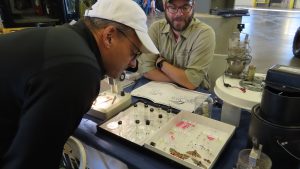Guidelines | The Williams County Vector Control District (WVCD) follows the most current guidelines from both the Centers for Disease Control (CDC) and the North Dakota Department of Health (NDDoH) when responding to the detection of a vector borne disease like West Nile Virus.
Risk Assessment | Vector Control uses a risk assessment calculator provided by a software program called VectorSurv. This calculator is adapted from the CDC and is used as a general guide for assessing the overall risk of an area. There are five surveillance categories where risk ranges from 1 (lowest risk) to 5 (highest risk). These categories and risk levels provide a general guide for district operations. Three of the 5 risk assessment categories are used: Environment, Abundance, and Infection. The other two, Seroconversion and Dead Bird Infections, are not used by Vector Control. These three are averaged to provide an overall risk. Additional details can be found on the VectoSurv website.
Mosquito Surveillance | Vector Control performs routine mosquito surveillance within the district using a network of mosquito traps. These traps are spread throughout the district and are designed to attract and catch various species of adult mosquito. Some of the traps are collected daily (excluding weekends/holidays) while others are placed during specific times and dates to focus on problem areas. A special type of trap is used when looking for mosquitoes that could be carrying a disease, such as West Nile Virus. These traps are designed to collect adult mosquitoes without killing them. Once the traps are emptied, the mosquitoes are quickly frozen and used for disease testing.
Testing | Vector Control uses a process called Polymerase Chain Reaction (PCR) to test mosquitoes for West Nile Virus (WNV), Saint Louis Encephalomyelitis virus (SLE), and Western Equine Encephalomyelitis virus (WEE). The use of PCR allows the district to quickly test for these diseases and to develop an appropriate action plan to mitigate the spread of these diseases to humans. If any of these viruses are detected in a mosquito pool, the district notifies the NDDoH, the local emergency rooms, and schedules a spray event for the area surrounding the collection site. This area will continue to be monitored until no virus is detected, after which normal surveillance resumes.
Action Thresholds | In addition to disease surveillance, Vector Control also manages nuisance mosquitoes common to the area. A set of action thresholds are defined for different classes of mosquito (nuisance VS disease vector). Once a threshold is reached, operations to manage the adult mosquito populations are initiated. An increase in the chance of disease transmission is not the only threshold used for increasing mosquito control activities. These include both aerial and ground sprays using an Ultra-Low Volume (ULV) application of a pesticide.

